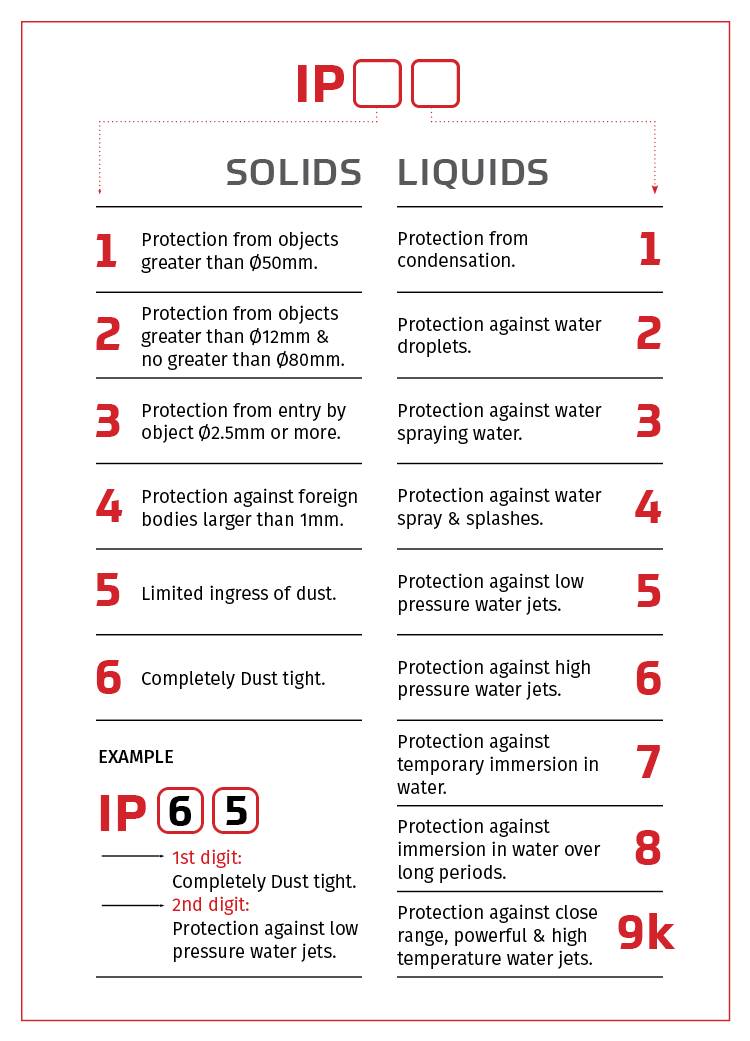
What do the two digits in an IP Rating mean?
IP Ratings are classified by categorical codes. The ratings consist of the letters IP followed by two digits, these summarise the scale of protection offered from dirt and moisture. If a number is replaced by 'X' this indicates that the enclosure is not rated for that specification.

LEVELS | PROTECTION | INTRUSION PROTECTION |
|---|---|---|
| 0 | Not Protected | No protection against contact and ingress of objects |
| 1 | > 50mm | Any large surface of the body, such as the back of a hand, but no protection against deliberate contact with a body part |
| 2 | > 12.5mm | Fingers or similar objects. |
| 3 | > 2.5mm | Tools, thick wires, etc. |
| 4 | > 1mm | Most wires, slender screws, large ants etc. |
| 5 | Dust Protected | Ingress of dust is not entirely prevented, but it must not enter in sufficient quantity to interfere with the satisfactory operation of the equipment; complete protection against contact. |
| 6 | Dust Tight | No ingress of dust; complete protection against contact (dust-tight). A vacuum must be applied. Test duration of up to 8 hours based on airflow. |
| LEVELS | PROTECTION | MOISTURE PROTECTION |
| 0 | Not Protected | No Protection |
| 1 | Dripping water | Dripping water (vertically falling drops) shall have no harmful effect. |
| 2 | Dripping water when tilted at 15° | Vertically dripping water shall have no harmful effect when the enclosure is tilted at an angle of 15° from its normal position. |
| 3 | Spraying water | Water falling as a spray at any angle up to 60° from the vertical shall have no harmful effect. |
| 4 | Splashing water | Water splashing against the enclosure from any direction shall have no harmful effect. |
| 5 | Water jets | Water projected by a nozzle (6.3 mm (0.25 in)) against enclosure from any direction shall have no harmful effects. |
| 6 | Powerful water jets | Water projected in powerful jets (12.5mm nozzle) against the enclosure from any direction shall have no harmful effects. |
| 6K | Powerful water jets with increased pressure | Water projected in powerful jets (6.3 mm (0.25 in) nozzle) against the enclosure from any direction, under elevated pressure, shall have no harmful effects. |
| 7 | Immersion up to 1m | Ingress of water in harmful quantity shall not be possible when the enclosure is immersed in water under defined conditions of pressure and time (up to 1 m of submersion). |
| 8 | Immersion beyond 1m | The equipment is suitable for continuous immersion in water under conditions which shall be specified by the manufacturer. Normally, this will mean that the equipment is hermetically sealed. However, with certain types of equipment, it can mean that water can enter but only in such a manner that it produces no harmful effects. |
| 9K | Powerful high-temperature water jets | Protected against close-range high pressure, high-temperature spray downs. Smaller specimens rotate slowly on a turntable, from 4 specific angles. Larger specimens are mounted in the intended position when being used, no turntable required, and are tested freehand for at least 3 minutes at a distance of 0.15–0.2 meters (5.9 in–7.9 in). |
1:IEC 60529 – “Degrees of protection provided by enclosures (IP Code)"
2:Wikipedia Article – “IP Code“
Disclaimer: *The information contained in this website is for general purposes only. Whilst we endeavour to keep the information up to date and as accurate as possible we make no representations or warranties of any kind, any reliance you place on such information is strictly at your own risk."References/More Information




















